标签:log end ima stp std alt sort virt null
原文:https://www.cnblogs.com/wanmeishenghuo/p/9688158.html 参考狄泰软件相关教程
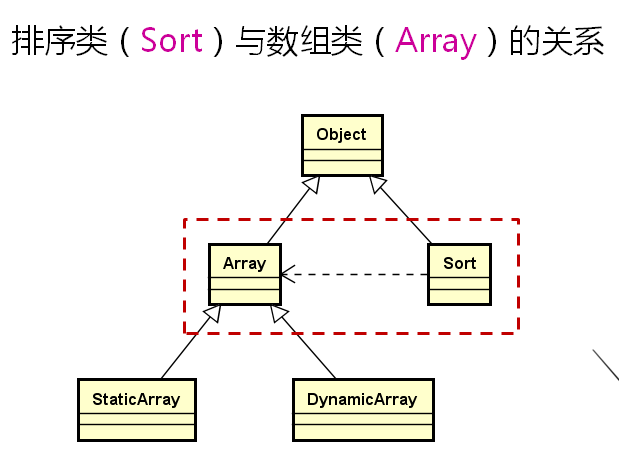
我们要使Srot能排序Array数组类。
Sort应该既能排序静态数组类又能排序动态数组类。
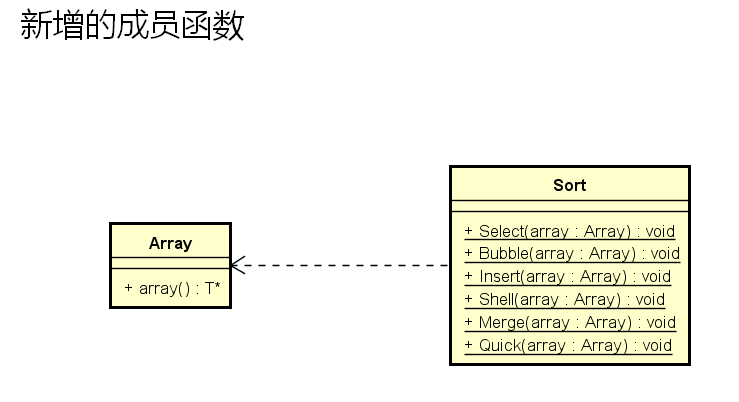
这个函数返回原生数组的首地址。
数组类需要新增成员函数array,排序类需要新增六个静态成员函数。
Array.h添加array函数:
#ifndef ARRAY_H
#define ARRAY_H
#include "Object.h"
#include "Exception.h"
namespace DTLib
{
template
class Array : public Object
{
protected:
T* m_array;
public:
virtual bool set(int i, const T&e) //O(1)
{
bool ret = ((0 >(*this))[i];
}
T* array()const
{
return m_array;
}
virtual int length() const = 0;
};
}
#endif // ARRAY_H
Sort.h改进如下:
#ifndef SORT_H
#define SORT_H
#include "Object.h"
#include
namespace DTLib
{
class Sort : public Object
{
private:
Sort();
Sort(const Sort&);
Sort& operator = (const Sort&);
template
static void Swap(T& a, T& b)
{
T c(a);
a = b;
b = c;
}
template
static void Merge(T src[], T helper[], int begin, int mid, int end, bool min2max=true)
{
int i = begin;
int j = mid + 1;
int k = begin; //代表辅助空间起始位置
while( (i src[j]) )
{
helper[k++] = src[i++];
}
else
{
helper[k++] = src[j++];
}
}
while( i
static void Merge(T src[], T helper[], int begin, int end, bool min2max)
{
if( begin
static int Partition(T array[], int begin, int end, bool min2max)
{
T pv = array[begin];
while( begin pv) : (array[end] = pv)) )
{
begin++;
}
Swap(array[begin], array[end]);
}
array[begin] = pv; //基准就位
return begin;
}
template
static void Quick(T array[], int begin, int end, bool min2max)
{
if( begin
static void Select(T array[], int len, bool min2max=true)
{
for(int i = 0; i array[j]) : (array[min]
static void Insert(T array[], int len, bool min2max=true)
{
for(int i=1; i =0) && (min2max ? (array[j] > e) : (array[j]
static void Bubble(T array[], int len, bool min2max=true)
{
bool exchange = true;
for(int i=0; (ii; j--)
{
if(min2max ? (array[j] array[j-1]))
{
Swap(array[j], array[j-1]);
exchange = true;
}
}
}
}
template
static void Shell(T array[], int len, bool min2max=true)
{
int d = len;
do
{
d = d / 3 + 1; //d的减小方式(实践证明这样做效果比较好)
for(int i = d; i =0) && (min2max ? (array[j] > e) : (array[j] 1 );
}
template
static void Merge(T array[], int len, bool min2max=true)
{
T* helper = new T[len];
if( helper != NULL )
{
Merge(array, helper, 0, len - 1, min2max);
}
delete[] helper;
}
template
static void Quick(T array[], int len, bool min2max=true)
{
Quick(array, 0, len - 1, min2max);
}
template
static void Select(Array& array, bool min2max=true)
{
Select(array.array(), array.length(), min2max);
}
template
static void Insert(Array& array, bool min2max=true)
{
Insert(array.array(), array.length(), min2max);
}
template
static void Bubbble(Array& array, bool min2max=true)
{
Bubble(array.array(), array.length(), min2max);
}
template
static void Shell(Array& array, bool min2max=true)
{
Shell(array.array(), array.length(), min2max);
}
template
static void Merge(Array& array, bool min2max=true)
{
Merge(array.array(), array.length(), min2max);
}
template
static void Quick(Array& array, bool min2max=true)
{
Quick(array.array(), array.length(), min2max);
}
};
}
#endif // SORT_H


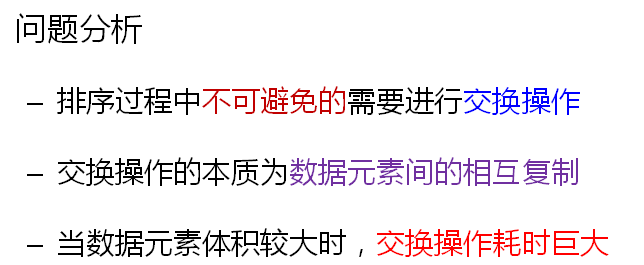
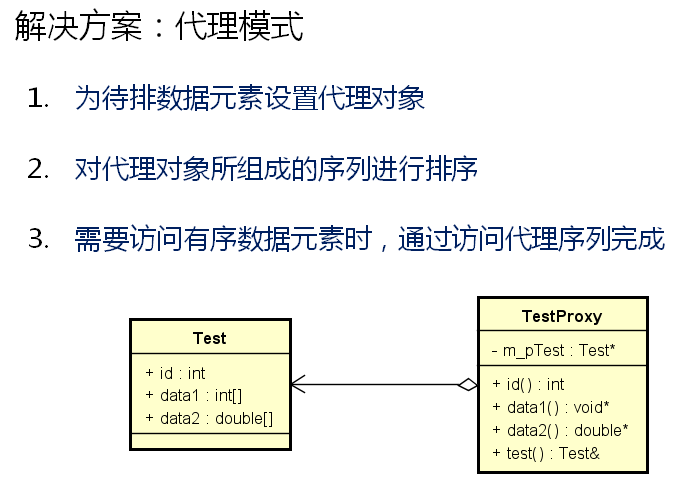
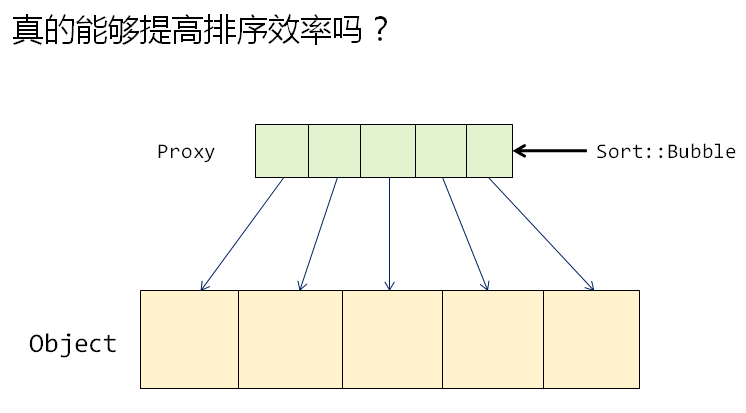

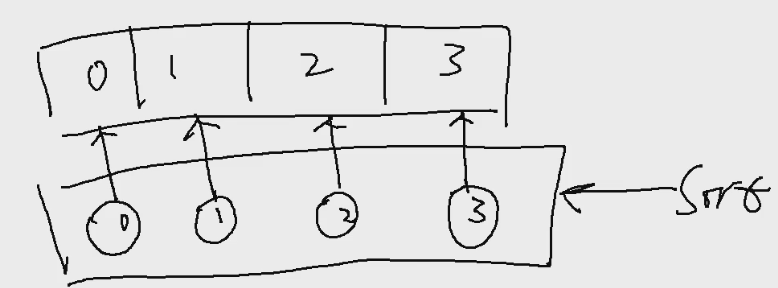
无代理时的测试程序:
#include
#include
#include "Sort.h"
using namespace std;
using namespace DTLib;
struct Test : public Object
{
int id;
int data1[1000];
double data2[500];
bool operator = (const Test& obj)
{
return id >= obj.id;
}
bool operator > (const Test& obj)
{
return id > obj.id;
}
bool operator
结果如下:
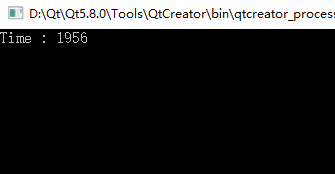
使用代理类:
#include
#include
#include "Sort.h"
using namespace std;
using namespace DTLib;
struct Test : public Object
{
int id;
int data1[1000];
double data2[500];
bool operator = (const Test& obj)
{
return id >= obj.id;
}
bool operator > (const Test& obj)
{
return id > obj.id;
}
bool operator id;
}
int* data1()
{
return m_pTest->data1;
}
double* data2()
{
return m_pTest->data2;
}
Test& test() const //请出委托者的函数
{
return *m_pTest;
}
bool operator = (const TestProxy& obj)
{
return test() >= obj.test(); //代理类对象的比较就是原始对象的比较
}
bool operator > (const TestProxy& obj)
{
return test() > obj.test(); //代理类对象的比较就是原始对象的比较
}
bool operator
结果如下:

小结:
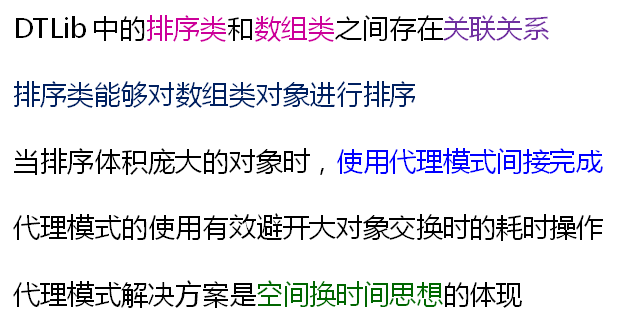
50 排序的工程应用示例
标签:log end ima stp std alt sort virt null
原文地址:https://www.cnblogs.com/lh03061238/p/13958174.html











